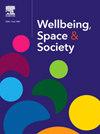On the impact of public art: How engaging a pedestrian-level exhibition improves neighborhood connectedness and well-being
IF 2.2
Q2 GEOGRAPHY
引用次数: 0
Abstract
How might publicly visible art enhance well-being and positively impact mental health? One aspect of art's potential lies in its capacity to foster a sense of connection to one's neighborhood or surroundings and to enhance feelings of community. Although this has long been a goal for artists and cultural initiatives, especially in urban areas, it has not been studied experimentally. To begin to fill this gap, we investigated how a free sidewalk-level exhibition about a neighborhood in Berlin, Germany altered visitors’ connection to and satisfaction with their neighborhood, as well as their overall well-being. Using a pre-registered pre-post design, we asked passers-by to engage with the exhibition, and their attitudes and well-being were assessed before and after the experience. We also considered participants’ cognitive-affective experiences and their agreement with the intended emotions of the artist and curator as factors predicting changes. Results showed that after engaging with the exhibition, participants (N = 64) felt significantly more connected to the neighborhood and reported improved well-being. These changes were higher when participants felt the emotions intended by the artist. Additionally, feeling expansive emotions and reporting higher cognitive appraisal in terms of meaningfulness and understanding of the art related to improved neighborhood connectedness. Our findings provide preliminary evidence suggesting that publicly accessible art may function as a community-connecting node. It highlights the role of the artist's intention, felt emotions, and cognitive appraisals shaping in the impact of neighborhood galleries. These insights research could inform future public art exhibitions and urban well-being interventionsfuture exhibitions and interventions.
关于公共艺术的影响:如何参与行人级展览改善社区连通性和福祉
公开可见的艺术如何提高幸福感并对心理健康产生积极影响?艺术潜力的一个方面在于它能够培养一个人与邻居或周围环境的联系感,并增强社区的感觉。虽然这一直是艺术家和文化活动的目标,特别是在城市地区,但还没有实验研究。为了填补这一空白,我们调查了一个关于德国柏林社区的免费人行道展览如何改变游客与社区的联系和满意度,以及他们的整体幸福感。采用预先注册的设计,我们邀请路人参与展览,并评估他们在体验前后的态度和幸福感。我们还考虑了参与者的认知情感体验以及他们对艺术家和策展人预期情绪的认同,作为预测变化的因素。结果显示,参与展览后,参与者(N = 64)明显感到与社区的联系更加紧密,并报告幸福感得到改善。当参与者感受到艺术家所表达的情感时,这些变化会更高。此外,感受广泛的情绪,并在意义和对艺术的理解方面报告更高的认知评价,这与改善邻里联系有关。我们的研究结果提供了初步的证据,表明公共可访问的艺术可能起到社区连接节点的作用。它强调了艺术家的意图、感受情感和认知评价在社区画廊的影响中所起的作用。这些见解研究可以为未来的公共艺术展览和城市福祉干预提供信息。
本文章由计算机程序翻译,如有差异,请以英文原文为准。
求助全文
约1分钟内获得全文
求助全文
来源期刊

Wellbeing Space and Society
Social Sciences-Social Sciences (miscellaneous)
CiteScore
2.70
自引率
0.00%
发文量
46
审稿时长
124 days
 求助内容:
求助内容: 应助结果提醒方式:
应助结果提醒方式:


